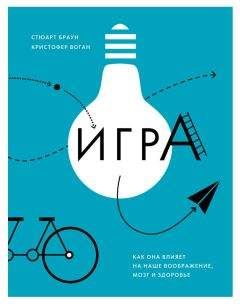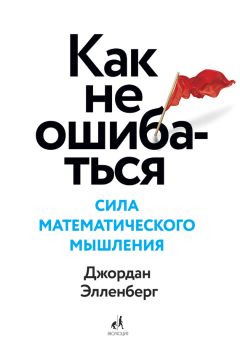Крис Пэйли - Не бери в голову. 100 фактов о том, как подсознание влияет на наши решения
Литература
1. H. Aarts, R. Custers, H. Marien. Preparing and motivating behavior outside of awareness. Science, 319 (5870):1639–1639, 2008.
2. J. M. Ackerman, c. C. Nocera, and J. A. Bargh. Incidental haptic sensations influence social judgments and decisions. Science, 328:1712–1714, 2010.
3. S. Aglioti, J. F. X. Desouza, and M. A. Goodale. Size-contrast illusions deceive the eye but not the hand. Current Biology, 5(6):679–685, 1995.
4. M. D. Alicke. Culpable causation. Journal of Personality and Social Psychology, 63(3): 368–378, 1992.
5. A. Alsius, J. Navarra, R. Campbell, and S. Soto-faraco. Audiovisual integration of speech falters under high attention demands. Current Biology, 15(9):839–843, 2005.
6. M. L. ANDERSON. Neural reuse: A fundamental organizational principle of the brain. Behavioral and Brain Sciences, 33(4):245–313, 2010.
7. J. Antonakis and O. Dalgas. Predicting elections: Child’s play. Science, 323:1183, 2009.
8. S. E. Asch. Opinions and social pressure. Scientific American, 193(5):31–35, 1955.
9. B. J. Baars. The conscious access hypothesis: Origins and recent evidence. Trends in Cognitive Sciences, 6(1):47–52, 2002.
10. G. J. Badger, W. K. Bickel, L. A. Giordano, E. A. Jacobs, G. Loewenstein, and L. Marsch. Altered states: The impact of immediate craving on the valuation of current and future opioids. Journal of Health Economics, 26(5):865–876, 2007.
11. J. N. Bailenson and N. Yee. Digital chameleons. Psychological Science, 16:814–819, 2005.
12. J. A. Bargh, M. Chen, and L. Burrows. Automaticity of social behavior: Direct effects of trait construct and stereotype activation on action. Journal of Personality and Social Psychology, 71(2):230–244, 1996.
13. S. Baron-Cohen. Mindblindness: An essay on autism and theory of mind. MIT Press, 1997.
14. S. Baron-Cohen, A. M. Leslie, and U. Frith. Does the autistic child have a ‘theory of mind’? Cognition, 21(1):37–46, 1985.
15. J. L. Barrett and A. H. Johnson. The role of control in attributing intentional agency to inanimate objects. Journal of Cognition and Culture, 3(3):208–217, 2003.
16. R. F. Baumeister, M. Gailliot, C. N. Dewall, and M. Oaten. Self-regulation and personality: How interventions increase regulatory success, and how depletion moderates the effects of traits on behavior. Journal of Personality, 74:1773–1801, 2006.
17. R. F. Baumeister and E. J. Masicampo. Conscious thought is for facilitating social and cultural interactions: How mental simulations serve the animal-culture interface. Psychological Review, 117(3):945–971, 2010.
18. R. F. Baumeister, E. J. Masicampo, and K. D. Vohs. Do conscious thoughts cause behavior? Annual Review of Psychology, 62:331–361, 2011.
19. R. F. Baumeister, B. J. Schmeichel, C. N. Dewall, and K. D. Vohs. Is the conscious self a help, a hindrance, or an irrelevance to the creative process? Advances in Psychology Research, 53:137–152, 2006.
20. R. F. Baumeister, J. M. Twenge, and C. K. Nuss. Effects of social exclusion on cognitive processes: Anticipated aloneness reduces intelligent thought. Journal of Personality and Social Psychology, 83:817–827, 2002.
21. R. F. Baumeister, K. D. Vohs, and D. M. Tice. The strength model of self-control. Current Directions in Psychological Science, 16:351–355, 2007.
22. D. J. Bem. Self-perception: An alternative interpretation of cognitive dissonance phenomena. Psychological Review, 74(3):183–200, 1967.
23. R. J. R. Blair. Responsiveness to distress cues in the child with psychopathic tendencies. Personality and Individual Differences, 27(1):135–145, 1999.
24. R. J. R. Blair. The amygdala and ventromedial prefrontal cortex in morality and psychopathy. Trends in Cognitive Sciences, 11(9):387–392, 2007.
25. L. B. Bräcker, K. P. Siju, N. Varela, Y. Aso, M. Zhang, I. Hein, M. L. Vasconcelos, and I. C. Grunwald Kadow. Essential role of the mushroom body in context-dependent CO2 avoidance in Drosophila. Current Biology, 23(13):1228–1234, 2013.
26. J. P. Brasil-Neto, A. Pascual-Leone, J. Valls-Solé, L. G. Cohen, and M. Hallett. Focal transcranial magnetic stimulation and response bias in a forced-choice task. Journal of Neurology, Neurosurgery & Psychiatry, 55(10):964–966, 1992.
27. K. A. Braun, R. Ellis, and E. F. Loftus. Make my memory: How advertising can change our memories of the past. Psychology & Marketing, 19(1):1–23, 2002.
28. C. A. Brown, B. Seymour, Y. Boyle, W. El-Deredy, and A. K. P. Jones. Modulation of pain ratings by expectation and uncertainty: Behavioral characteristics and anticipatory neural correlates. Pain, 135(3):240–250, 2008.
29. J. M. Burger. The foot-in-the-door compliance procedure: A multiple-process analysis and review. Personality and Social Psychology Review, 3(4):303–325, 1999.
30. J. T. Cacioppo, L. C. Hawkley, and G. G. Bernston. The anatomy of loneliness. Current Directions in Psychological Science, 12:71–74, 2003.
31. P. Carruthers. How we know our own minds: The relationship between mindreading and metacognition. Behavioral and Brain Sciences, 32(2):121–182, 2009.
32. H. A. Chapman, D. A. Kim, J. M. Susskind, and A. K. Anderson. In bad taste: Evidence for the oral origins of moral disgust. Science, 323:1222–1226, 2009.
33. T. L. Chartrand and J. A. Bargh. The chameleon effect: The perception-behavior link and social interaction. Journal of Personality and Social Psychology, 76:893–910, 1999.
34. T. L. Chartrand, J. Huber, B. Shiv, and R. J. Tanner. Non-conscious goals and consumer choice. Journal of Consumer Research, 35(2):189–201, 2008.
35. T. L. Chartrand, S. Pinckert, and J. M. Burger. When manipulation backfires: The effects of time delay and requester on the foot-in-the-door technique. Journal of Applied Social Psychology, 29(1):211–221, 1999.
36. M. Chen and J. A. Bargh. Nonconscious behavioral confirmation processes: The self-fulfilling consequences of automatic stereotype activation. Journal of Experimental Social Psychology, 33(5):541–560, 1997.
37. J. J. Christensen-Szalanski. Discount functions and the measurement of patients’ values: Women’s decisions during child-birth. Medical Decision Making, 4(1):47–58, 1984.
38. R. B. Cialdini. Crafting normative messages to protect the environment. Current Directions in Psychological Science, 12(4):105–109, 2003.
39. R. B. Cialdini, L. J. Demaine, B. J. Sagarin, D. W. Barrett, K. Rhoads, and P. L. Winter. Managing social norms for persuasive impact. Social Influence, 1(1):3–15, 2006.
40. R. B. Cialdini and N. J. Goldstein. Social influence: Compliance and conformity. Annual Review of Psychology, 55:591–621, 2004.
41. S. A. Clancy, R. J. Mcnally, D. L. Schacter, M. F. Lenzenweger, and R. K. Pitman. Memory distortion in people reporting abduction by aliens. Journal of Abnormal Psychology, 111(3):455–461, 2002.
42. J. J. Clarkson, E. R. Hirt, L. Jia, and M. B. Alexander. When perception is more than reality: The effects of perceived versus actual resource depletion on self-regulatory behavior. Journal of Personality and Social Psychology, 98(1):29–46, 2010.
43. M. K. Colvin and M. S. Gazzaniga. Split-brain cases. In M. S. Velmans and S. Schneider, editors, The Blackwell Companion to Consciousness, pages 181–193. Blackwell Publishing, 2006.
44. J. Correll, B. Park, C. M. Judd, and B. Wittenbrink. The police officer’s dilemma: Using ethnicity to disambiguate potentially threatening individuals. Journal of Personality and Social Psychology, 83(6):1314, 2002.
45. R. Custers and H. Aarts. The unconscious will: How the pursuit of goals operates outside of conscious awareness. Science, 329(5987):47–50, 2010.
46. J. M. Darley and P. H. Gross. A hypothesis-confirming bias in labeling effects. Journal of Personality and Social Psychology, 44(1):20–33, 1983.
47. J. M. R. Delgado. Physical Control of the Mind: Toward a Psychocivilized Society. Harper and Row, 1969.
48. C. N. Dewall, R. F. Baumeister, and E. J. Masicampo. Evidence that logical reasoning depends on conscious processing. Consciousness and Cognition, 17(3):628–645, 2008.
49. A. Dijksterhuis. Automaticity and the unconscious. In S. T. Fiske, D. T. Gilbert, and G. Lindzey, editors, Handbook of Social Psychology, pages 228–267, 2010.
50. A. Dijksterhuis, M. W. Bos, L. F. Nordgren, and R. B. Van Baaren. On making the right choice: The deliberation-without-attention effect. Science, 311(5763):1005–1007, 2006.
51. J. Doyon and H. Benali. Reorganization and plasticity in the adult brain during learning of motor skills. Current Opinion in Neurobiology, 15(2):161–167, 2005.
52. R. I. M. Dunbar. The social brain hypothesis. Evolutionary Anthropology, 6:178–190, 1998.
53. R. I. M. Dunbar and S. Shultz. Evolution in the social brain. Science, 317(5843):1344–1347, 2007.
54. D. G. Dutton and A. P. Aron. Some evidence for heightened sexual attraction under conditions of high anxiety. Journal of Personality and Social Psychology, 30:510–517, 1974.
55. A. J. Elliot, D. Niesta Kayer, T. Greitemeyer, S. Lichtenfeld, R. H. Gramzow, M. A. Maier, and H. Liu. Red, rank, and romance in women viewing men. Journal of Experimental Psychology: General, 139:399–417, 2010.
56. A. J. Elliot and D. Niesta. Romantic red: Red enhances men’s attraction to women. Journal of Personality and Social Psychology, 95:1150–1164, 2008.
57. N. Epley, A. Waytz, and J. T. Cacioppo. On seeing human: A three-factor theory of anthropomorphism. Psychological Review, 114(4):864–886, 2007.
58. M. H. Erdelyi. A new look at the new look: Perceptual defense and vigilance. Psychological Review, 81(1):1–25, 1974.
59. X. Fang, S. Singh, and R. Ahluwalia. An examination of different explanations for the mere exposure effect. Journal of Consumer Research, 34(1):97–103, 2007.
60. R. H. Fazio, J. R. Jackson, B. C. Dunton, and C. J. Williams. Variability in automatic activation as an unobtrusive measure of racial attitudes: A bona fide pipeline? Journal of Personality and Social Psychology, 69(6):1013–1027, 1995.
61. R. Ferraro, J. R. Bettman, and T. L. Chartrand. The power of strangers: The effect of incidental consumer brand encounters on brand choice. Journal of Consumer Research, 35(5):729–741, 2009.
62. L. Festinger. A Theory of Cognitive Dissonance, 2. Stanford University Press, 1962.
63. L. Festinger and J. M. Carlsmith. Cognitive consequences of forced compliance. The Journal of Abnormal and Social Psychology, 58(2):203–210, 1959.
64. L. Festinger, H. W. Riecken, and S. Schachter. When Prophecy Fails. University of Minnesota Press, 1956.
65. A. Floyer-Lea and P. M. Matthews. Changing brain networks for visuomotor control with increased movement automaticity. Journal of Neurophysiology, 92(4):2405–2412, 2004.
66. P. Fourneret and M. Jeannerod. Limited conscious monitoring of motor performance in normal subjects. Neuropsychologia, 36(11):1133–1140, 1998.
67. J. L. Freedman and S. C. Fraser. Compliance without pressure: The foot-in-the-door technique. Journal of Personality and Social Psychology, 4(2):195, 1966.
68. U. Frith and F. Happé. Theory of mind and self-consciousness: What is it like to be autistic? Mind and Language, 14(1):82–89, 1999.
69. M. T. Gailliot and R. F. Baumeister. The physiology of willpower. Personality and Social Psychology Review, 11(4):303–327, 2007.
70. M. T. Gailliot and R. F. Baumeister. Self-regulation and sexual restraint: Dispositionally and temporarily poor self-regulatory abilities contribute to failures at restraining sexual behavior. Personality and Social Psychology Bulletin, 33(2):173–186, 2007.
71. M. T. Gailliot, R. F. Baumeister, C. N. Dewall, J. K. Maner, E. A. Plant, D. M. Tice, L. E. Brewer, and B. J. Schmeichel. Self-control relies on glucose as a limited energy source: Willpower is more than a metaphor. Journal of Personality and Social Psychology, 92:325–336, 2007.
72. M. T. Gailliot, B. M. Peruche, E. A. Plant, and R. F. Baumeister. Stereotypes and prejudice in the blood: Sucrose drinks reduce prejudice and stereotyping. Journal of Experimental Social Psychology, 45(1):288–290, 2009.
73. M. S. Gazzaniga. Cerebral specialization and interhemispheric communication: Does the corpus callosum enable the human condition? Brain, 123(7):1293–1326, 2000.
74. N. J. Goldstein, R. B. Cialdini, and V. Griskevicius. A room with a viewpoint: Using social norms to motivate environmental conservation in hotels. Journal of Consumer Research, 35(3):472–482, 2008.
75. J. D. Greene, L. E. Nystrom, A. D. Engell, J. M. Darley, and J. D. Cohen. The neural bases of cognitive conflict and control in moral judgment. Neuron, 44(2):389–400, 2004.
76. J. D. Greene, R. B. Sommerville, L. E. Nystrom, J. M. Darley, and J. D. Cohen. An fMRI investigation of emotional engagement in moral judgment. Science, 293:2105–2108, 2001.
77. A. G. Greenwald, D. E. McGhee, and J. L. K. Schwartz. Measuring individual differences in implicit cognition: The implicit association test. Journal of Personality and Social Psychology, 74(6):1464–1480, 1998.
78. D. M. Gromet and E. Pronin. What were you worried about? Actors’ concerns about revealing fears and insecurities relative to observers’ reactions. Self and Identity, 8(4):342–364, 2009.
79. N. Guéguen. Mimicry and seduction: An evaluation in a courtship context. Social Influence, 4:249–255, 2009.
80. C. L. Hafer and L. Bégue. Experimental research on just-world theory: Problems, developments, and future challenges. Psychological Bulletin, 131:128–167, 2005.
81. A. M. Haffenden, K. C. Schiff, and M. A. Goodale. The dissociation between perception and action in the Ebbinghaus illusion: Nonillusory effects of pictorial cues on grasp. Current Biology, 11(3):177–181, 2001.
82. J. Haidt and S. Kesebir. Morality. In S. T. Fiske, D. T. Gilbert, and G. Lindzey, editors, Handbook of Social Psychology, pages 797–832, 2010.
83. W. T. Harbaugh, U. Mayr, and D. R. Burghart. Neural responses to taxation and voluntary giving reveal motives for charitable donations. Science, 316:1622–1625, 2007.
84. R. D. Hare, S. D. Hart, and T. J. Harpur. Psychopathy and the DSM – IV criteria for antisocial personality disorder. Journal of Abnormal Psychology, 100(3):391–398, 1991.
85. A. A. Harrison. Mere exposure. Advances in Experimental Social Psychology, 10:39–83, 1977.
86. L. C. Hawkley and J. T. Cacioppo. Loneliness and pathways to disease. Brain, Behavior, and Immunity, 17: S98–S105, 2002.
87. M. Höfle, M. Hauck, A. K. Engel, and D. Senkowski. Viewing a needle pricking a hand that you perceive as yours enhances unpleasantness of pain. Pain, 153(5):1074–1081, 2012.




